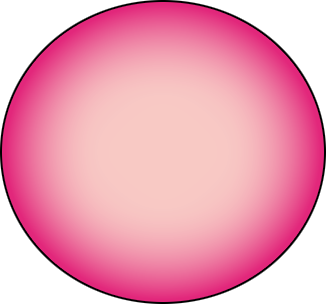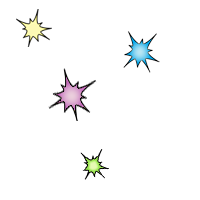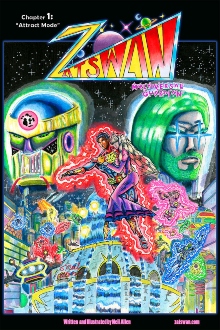Justice League: The Animated Series – Part 1: Prelude to Justice
on March 24, 2015
Part 3: Green Lantern Meets Hawkgirl
Part 4: Season 2-Bigger, Better, More Daring
Part 5: More Than Just a Kids’ Show

In 1992, Warner Bros. released a Batman cartoon show to capitalize on the success of the Tim Burton Batman films of the late ’80s and early ’90s. With Bruce Timm as its producer, the show boasted an incredible amount of style and sophistication. From the voice acting, to the soundtrack, the writing, art design and more, Batman: The Animated Series displayed a surprising level of maturity and complexity. So much that despite being a children’s cartoon, many older viewers were drawn into the dark, classy world of the Caped Crusader.
Batman: The Animated Series was a breakthrough and benchmark for superhero cartoons from then on, and was widely recognized as such, winning four Emmy Awards and frequently listed among the greatest cartoons ever made. It played a huge role in securing Batman as a major franchise after the titular character had declined in popularity in the ’70s and first part of the ’80s.
Bruce Timm’s success was so great that he and his team were asked to do the same thing with DC Comics’ flagship character, Superman. In 1996, Superman: The Animated Series took to air waves, and though it wasn’t as culturally influential as Batman: The Animated Series –likely due in part to not being the first– it was also a big success for Warner Bros.
The two shows established continuity between each other, forming a shared universe. First it was through small hints, and later a full blown Superman and Batman team up in the three part story “World’s Finest.”
Along with the shows Batman Beyond and Static Shock, these programs formed what came to be known as the DC Animated Universe.
Many fans thought the next logical step was a Justice League of America show, which would feature Superman and Batman teamed with other heroes from the DC Comics Universe. Bruce Timm shied away from this because he felt it would be too difficult from a technical perspective. He and his team oftentimes had their hands full handling one main character, and working with a whole team of heroes with amazing powers would be considerably more challenging. Another factor that deterred him was regularly finding ways to believably test such a high powered force. Bruce Timm even went as far to say he would NEVER do a Justice League cartoon.
 |
|
The animated Justice League roster. |
Yet, eventually, the stars were aligned. After the Batman Beyond episode “The Call,” which features a futuristic Justice League, Bruce Timm felt he could do it. Furthermore, the Justice League was getting resurgence in popularity with the JLA comics by writer Grant Morrison. With fan demand higher than ever, and Bruce Timm confident in himself and his team’s abilities, it was the right time to finally tackle The World’s Greatest Heroes. Timm got on the phone with Cartoon Network executives and sealed the deal.
Some production decisions caused controversy among the anticipating fanbase. Bruce Timm took the traditional Justice League of America line up into consideration, and noted that what may have worked with a narrow comics audience may not work as well with a show going out to millions and millions of diverse people around the world.
Aquaman, a long standing staple and founder of the Justice League, was replaced with Hawkgirl, who was largely presented as a sidekick of Hawkman in the comics mythology.
An issue Bruce Timm found with the Justice League founders in the comics was that Wonder Woman was the only female hero present. The inclusion of Hawkgirl rectified that. Furthermore, she is a personal favorite of Timm’s, with him being a big fan of her design. He wanted the Hawk family represented and felt Hawkgirl was cooler than Hawkman. Furthermore, Bruce Timm was adamant about not wanting his Justice League to be perceived as kitschy, like the old Super Friends cartoons, and Aquaman is the most criticized character from those shows, with a power set often thought to be useless and goofy.
Admittedly, Hawkgirl’s power set was also limited, consisting primarily of flight, super strength, and heightened resilience; abilities other heroes in the League possess, and in greater capacity. The creative team evened things out by giving Hawkgirl a powerful energy mace made of the alien Nth metal, which has magic repelling properties. This is a particularly clever addition, since Superman isn’t invulnerable to magic, and many threats associated with Wonder Woman are of mystical nature.
The differences between Hawkgirl and Wonder Woman are very interesting. Hawkgirl is used to offset Wonder Woman, who is presented as the perfect woman. Wonder Woman is almost unbelievably beautiful, royal, formal, and a bit aloof. She is often likened to a supermodel, whereas Hawkgirl is the more approachable girl next door type.
In the comics, there have been numerous characters to use the ‘Hawkgirl’ name over the decades. Timm’s version takes most of its cues from the Silver Age Hawkgirl. Her backstory for the cartoon is similar to that of the comics. In Justice League, Shayera Hol was an undercover detective on her home world of Thanagar who was zapped by a Zeta beam while pursuing criminals trafficking in forbidden technology. The beam’s effects transported her far across the universe to the uncharted planet Earth. Not knowing how to get back home, she took up residence on the planet and adopted the superhero alias of Hawkgirl.
 |
|
Producer Bruce Timm breaks comic tradition by including Hawkgirl as a founder of the League. This forward-thinking move makes it so Wonder Woman isn’t the only female on the team. |
Prior to Justice League, Hawkgirl wasn’t a very well-known character with general audiences, and the producers used this to their advantage, completely reinventing the character and building her personality from the ground up to suit their whims. Hawkgirl is rather mysterious. She doesn’t talk much about herself or her past, though it is known she comes from a warlike planet. She is a savage combatant, and it is even suggested that she is used to killing her enemies, unlike the other League members. She sometimes has difficulty going against her habits while playing by the Justice League’s rules. Despite her ferocity in combat, she is usually amiable with her teammates… except where the Green Lantern is involved.
The Green Lantern and Hawkgirl have the most fascinating interpersonal relations in the Justice League, and even the entire DC Animated Universe. They have quite a love-hate relationship and a very distinct dynamic unto themselves.
Speaking of Green Lantern, perhaps the most controversial decision was using the John Stewart version for the role. At the time, Kyle Rayner was the Green Lantern in DC Comics, including the JLA comic series. John Stewart was the Green Lantern in the 1980s, and he starred in the early ’90s comic series Green Lantern: Mosaic. By the time Justice League was coming out in 2001, John Stewart hadn’t been Green Lantern for several years, and even then, he hadn’t left as large a mark on the Green Lantern franchise as other protagonists, like Hal Jordan or Kyle Rayner, so the decision to use this inactive and then lesser known Green Lantern was very confusing to some.
Bruce Timm openly admitted that the Justice League needed diversity, and the African American John Stewart keeps the League from being an all-White affair. Comics, being the rather closed in industry and market that it is, hardly ever addressed the point of diversity. They were primarily made by and marketed toward White males. But, again, the Justice League cartoon was going into the homes of millions of people from various backgrounds, thus the producers thought it wise to include a person of color on the team.
Despite that, some fans still took issue with the decision, pointing out that a Green Lantern had already been introduced in the Superman: The Animated Series episode “Brightest Day.” That episode featured an amalgamation that had Kyle Rayner’s name and job, but the look and origin of Hal Jordan.
Ever aware of their continuity, the producers made it so John Stewart fit perfectly with what was established in the Superman episode. “Brightest Day” featured the death of Abin Sur –the Green Lantern of Space Sector 2814– and the introduction of the Green Lantern Corps. Abin’s power ring passed to cartoonist Kyle Rayner. Sometime after those events, Rayner departed Earth for training as a Green Lantern, and Earthman John Stewart was recalled by his masters, The Guardians of the Universe, to Sector 2814 to be the protector of that division of space.
John returned home to Earth after serving the Green Lantern Corps in deep space for ten years. To his surprise, he reeled from culture shock when he found he was no longer in tune with what he expected to be familiar surroundings and people. Having become so accustomed to otherworldly environs, Earth was just as alien to him as any far flung world he encountered in his adventures. Feeling estranged from his ‘home’ and the people he is charged with protecting, John worries he’s lost his humanity.
 |
|
Another deviation from the original ’60s comics is the inclusion of John Stewart as Green Lantern. Though Hawkgirl and Green Lantern began as the most controversial parts of the show among comic purists, Bruce Timm and his team put great effort into building them into intriguing characters that won audiences over. |
Bruce Timm presented a new and intriguing take on the John Stewart character and further reinvented him by giving him a past in the U.S. Marine Corps along with no nonsense, gruff and sometimes judgmental tendencies. The combination of Hawkgirl’s headstrong, combative, and short tempered characteristics, with Green Lantern’s sanctimonious inclinations makes for a very fun interconnection between the duo.
The two most controversial characters, Green Lantern and Hawkgirl, were given a lot of care from the producers, and went on to become extremely popular and recognized, even to the point where John Stewart is now arguably the most known and popular Green Lantern character. When the trailer for the 2011 Green Lantern film starring Ryan Reynolds as Hal Jordan was released, scores of people were outraged by the movie featuring a White Green Lantern. Interestingly, the movie wound up being a colossal box office bomb, losing around 100 million dollars. Most of the products related to it did not sell, causing stores to refuse to stock Green Lantern merchandise centered on Hal Jordan’s story.
The revamping of John Stewart was so successful that Bruce Timm’s version is now the template for the character in all other media, including comic books. John Stewart was always a successful character –with his tenure as Green Lantern in the ’80s doubling sales on the GL comic title, and his Green Lantern: Mosaic series being a strong seller and critical darling– but Justice League propelled him to another level of acclaim, esteem, and fame. Going from comic book obscurity to worldwide recognition, John Stewart is not only perhaps the most widely recognized Green Lantern, but also the most popular minority character in DC Comics.
Some will say Batman: The Animated Series is the crowning jewel of Bruce Timm’s career, but I feel that Justice League is Timm’s true tour de force, and the pinnacle of the entire DC Animated Universe. I certainly recognize the accomplishments of Batman, but Justice League simply has… more. More of everything!
This isn’t to say that MORE is necessarily better, but Justice League takes everything to another level. The relationships between characters are deeper and more fascinating. The action scenes are far and away superior. There’s greater diversity in characters, set pieces, plots, and themes. There are more characters for people in the audience to relate to. Girls can get in on the wish fulfillment aspect of superheroes with Wonder Woman and Hawkgirl, and people of color with Green Lantern. And believe me, that last point makes a big difference to demographics that usually don’t get strong characters with powerful, admirable roles in fantasy adventure stories who reflect them.
Utilizing an hour long format that splits most of its stories into two part episodes, which are frequently aired back to back, each story feels like a mini movie. This format was never done in cartoons prior to Justice League. Bruce Timm and his team blazed new trails successfully, with each adventure being a vast, engrossing epic, which is just what a concept like the Justice League requires.
The level at which the production team got into their jobs and knows the source material is surprising. What else is impressive is that they know what to take, what to leave, and what to change, all to make for the best show that could have been done, thus making Justice League a lot more powerful and consistently impressive than any of the comics iterations.
Not only is Justice League the pinnacle of the DC Animated Universe, it is also the greatest action cartoon there has yet been. Compared to any other superhero cartoon, any anime, or any animated thing, Justice League is firmly at the top for me. And it’s not a terribly uncommon sentiment! Justice League is a consistent placeholder in lists for greatest cartoons of all time.
Let’s take a look at the legendary stories that make it so…
Continue to Part 2: The Golden Age



















